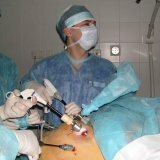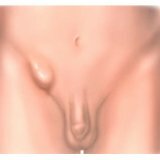Surgical treatment of obesity
 Obesity is a significant increase in body weight due to fat deposits in different parts of the body.Physiological storage "places" are hips, abdomen, buttocks, mammary glands.Excessive obesity is a pathology of metabolism that can appear at any age.
Obesity is a significant increase in body weight due to fat deposits in different parts of the body.Physiological storage "places" are hips, abdomen, buttocks, mammary glands.Excessive obesity is a pathology of metabolism that can appear at any age.
Reasons for obesity
 The incidence of obesity in developed countries is very high.Most cases of the onset of the development of pathology are not associated with genetic factors. In the mechanism of the emergence of excess weight lies the imbalance between energy needs and costs.As a result of consuming high-calorie food and an insufficient level of energy consumption, an accumulation of adipose tissue consisting of triglycerides occurs.But sometimes in the development of the disease can be traced and hereditary relationship. Among the factors causing obesity are:
The incidence of obesity in developed countries is very high.Most cases of the onset of the development of pathology are not associated with genetic factors. In the mechanism of the emergence of excess weight lies the imbalance between energy needs and costs.As a result of consuming high-calorie food and an insufficient level of energy consumption, an accumulation of adipose tissue consisting of triglycerides occurs.But sometimes in the development of the disease can be traced and hereditary relationship. Among the factors causing obesity are:
- overeating, in which the amount of food exceeds energy requirements;
- non-endocrine disorders that develop in diseases of the gastrointestinal tract, liver, pancreas;
- lack of mobility and sedentary work;
- genetic predisposition with an increase in the activity of enzymes that cause fat deposition( lipogenesis) and a decrease in the ability of lipolysis enzymes( fission of fats);
- endocrine pathology( hypothyroidism, insulinoma);
- mental illness with excessive appetite;
- stress states( reference), insufficient sleep;
- reception of psychotropic medications.
Species, degrees and classification of obesity
The most common type of obesity is central. With it, excess fat is deposited in the abdomen.Determine the presence of this type of excess weight can be by the ratio of waist volume and hip volume.For women, it is higher than 0.8, for men it is more than 0.95. The pathological type of is caused by endocrine problems that lead to excessive deposition of adipose tissue.Degrees of excess weight are estimated by BMI - the body mass index.This is a fairly common method of determining the stage of obesity.The ratio of height and weight of a person is represented by the formula: BMI = mass( in kg): height2( in m) In this case, if the index:
- to 16 - body weight is sharply reduced;
- 16 - 18.5 - body weight is inadequate;
- 18,5 - 24,9 - normal weight;
- 24,9 - 30 - weighted-up;Obesity of the first degree;
- 30 - 35;Obesity of the second degree is
- 35 - 40;Obesity of the third degree is
- 40 - 45.
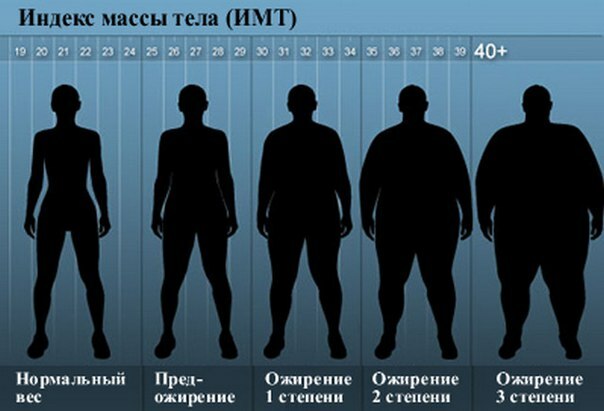 In addition to this method, there are many other methods for determining excess weight. Important: , about 5% of the population suffers from grade 3 obesity, which poses a threat not only to the health, but even to the life of the patient. In these cases, excess body weight is accompanied by a number of concomitant diseases( cardiovascular failure, diabetes, joint and spinal diseases, etc.).
In addition to this method, there are many other methods for determining excess weight. Important: , about 5% of the population suffers from grade 3 obesity, which poses a threat not only to the health, but even to the life of the patient. In these cases, excess body weight is accompanied by a number of concomitant diseases( cardiovascular failure, diabetes, joint and spinal diseases, etc.).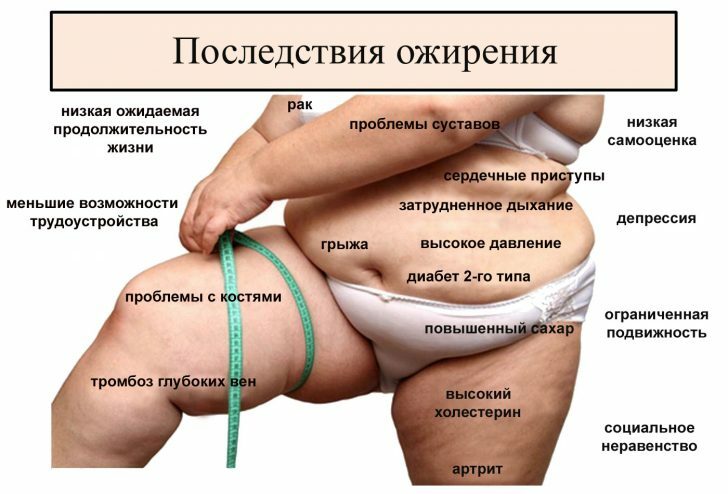 Note: the average life expectancy of obese patients is reduced by 15 years, and the mortality rate is 12 times higher than in people with normal weight. All non-surgical treatments for overweight are ineffective.Even in case of a decrease in body weight by diets, psychomethodics, acupuncture, medication, it is rather difficult to keep weight.Attempts to find a solution to the problem of obesity led doctors to introduce surgical methods of weight correction.
Note: the average life expectancy of obese patients is reduced by 15 years, and the mortality rate is 12 times higher than in people with normal weight. All non-surgical treatments for overweight are ineffective.Even in case of a decrease in body weight by diets, psychomethodics, acupuncture, medication, it is rather difficult to keep weight.Attempts to find a solution to the problem of obesity led doctors to introduce surgical methods of weight correction.
When surgical intervention is necessary for obesity
If the weight in a person begins to exceed the norm by 45-50 kg, the mass index goes to the level of 35-40, then you should think about the possible use of surgical intervention.Especially if serious diseases are added to obesity.Operations are assigned primarily to people aged 18 to 60 years.But there are cases when it is shown in both earlier and later age. Abstain from surgical treatment if the patient suffers:
- chronic alcoholism;
- addiction;
- mental pathology;
- disease in the stage of decompensation.
In the case of existing neglected diseases, preparation with preliminary treatment of the underlying disease is required.
Types of surgical operations for the treatment of obesity
Before analyzing operations with cavity access, it is necessary to dwell on maladventive treatment methods.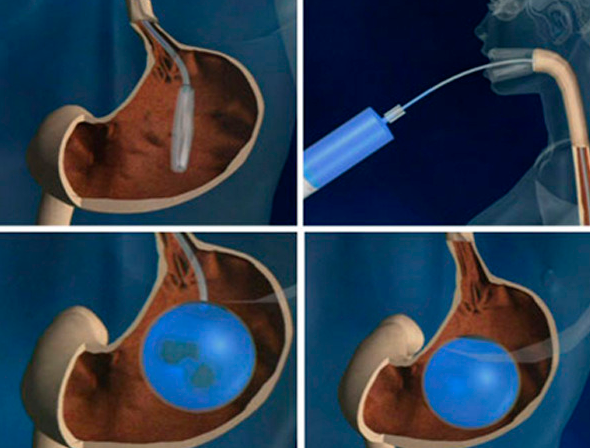 In this method of treatment with a special endoscope, a balloon of silicone elastomers is introduced into the stomach, which is filled with a certain volume of fluid, depending on the size of the stomach, the degree of obesity and the goal.Usually from 400 to 700 ml.As a result, when eating a person, a very fast and prolonged feeling of satiety occurs, which leads to a decrease in consumed food.The life of the balloon in the stomach is several( from 4 to 6) months.During this time the patient loses about 30 kg of weight.This result with the advanced stages of obesity is not too high, but it gives a push to the patient to continue the begun "struggle".A person reconsiders his diet, the amount of food, the way of life.There is a psychological reorganization with the formation of new ideals, habits.Well, if the obese patient does not stop there and agrees to more radical ways of treatment, since the further progress in the procedure for installing an intragastric balloon is observed only in 10% of cases.The rest or keep the result, or gain weight again.The technique can be applied repeatedly.Most often, the balloon is shown in cases of moderate stages of obesity, especially - in combination with conservative therapy, or vice versa - with excessive obesity, if radical surgery is impossible or preparation is required.
In this method of treatment with a special endoscope, a balloon of silicone elastomers is introduced into the stomach, which is filled with a certain volume of fluid, depending on the size of the stomach, the degree of obesity and the goal.Usually from 400 to 700 ml.As a result, when eating a person, a very fast and prolonged feeling of satiety occurs, which leads to a decrease in consumed food.The life of the balloon in the stomach is several( from 4 to 6) months.During this time the patient loses about 30 kg of weight.This result with the advanced stages of obesity is not too high, but it gives a push to the patient to continue the begun "struggle".A person reconsiders his diet, the amount of food, the way of life.There is a psychological reorganization with the formation of new ideals, habits.Well, if the obese patient does not stop there and agrees to more radical ways of treatment, since the further progress in the procedure for installing an intragastric balloon is observed only in 10% of cases.The rest or keep the result, or gain weight again.The technique can be applied repeatedly.Most often, the balloon is shown in cases of moderate stages of obesity, especially - in combination with conservative therapy, or vice versa - with excessive obesity, if radical surgery is impossible or preparation is required.
Method of gastric banding
It was developed in the early 80's.First, the operation was carried out using the method of unregulated dredging.The stomach was segmented in the form of "hourglass" with the creation of a "small stomach" in the upper part( subcardia), resulting in a feeling of satiety from the use of a small amount of food.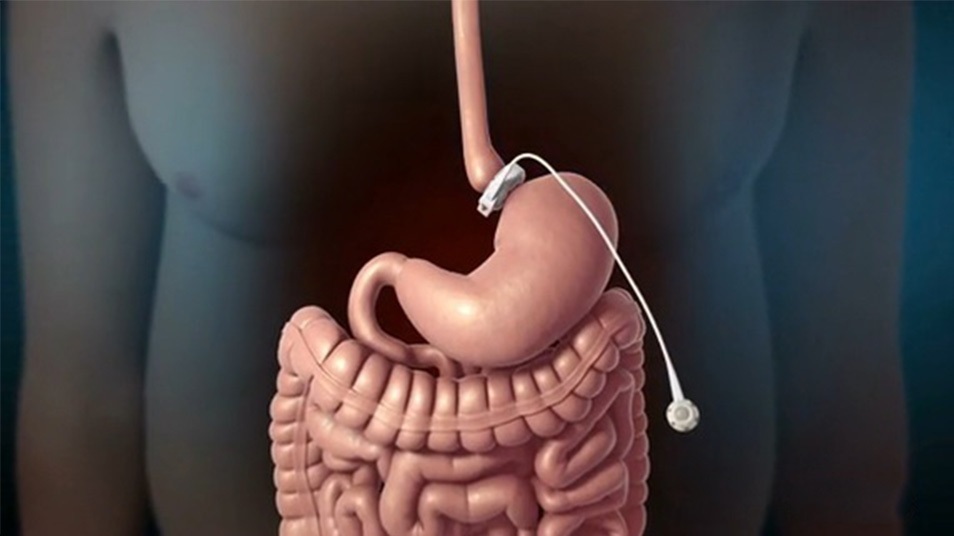 A little later, a model of an adjustable gastric band was created.As a "waist" served as a silicone, which did not expose human tissue to harmful effects.Bandage is a ring, the inner part of which contains a membrane.In the case of filling it with a special fluid, the bandage contracts and causes a decrease in the gap between parts of the stomach.The tube emerging from the membrane comes out to the special device under the skin.Through it, by injection, liquid is supplied to the cuff.The volume of the "small" stomach was formed in such a way that 5-15 ml of food was placed in it.The technique of surgical treatment was improved over time and subsequently surgical intervention was replaced by laparoscopic surgery - through punctures in the abdominal wall, which significantly reduced trauma and improved prognosis. Banding complications:
A little later, a model of an adjustable gastric band was created.As a "waist" served as a silicone, which did not expose human tissue to harmful effects.Bandage is a ring, the inner part of which contains a membrane.In the case of filling it with a special fluid, the bandage contracts and causes a decrease in the gap between parts of the stomach.The tube emerging from the membrane comes out to the special device under the skin.Through it, by injection, liquid is supplied to the cuff.The volume of the "small" stomach was formed in such a way that 5-15 ml of food was placed in it.The technique of surgical treatment was improved over time and subsequently surgical intervention was replaced by laparoscopic surgery - through punctures in the abdominal wall, which significantly reduced trauma and improved prognosis. Banding complications:
- slippage syndrome( slip of the bandage);
- dilatation of the small stomach( stretching the wall and increasing the volume);
- the passage of the bandage into the lumen of the stomach( migration);
- damage cuff, injector, connector.
The patient who underwent this type of operation should be under the supervision of a physician, so that the specialist should monitor the level of weight loss and the regulation of the diameter of the interventricular orifice.
Method of vertical gastroplasty
Introduced in the 80s by the physicians of the United States of America.By surgical stitching, the stomach is divided into a small part with a volume of 10 to 18 ml and most.Separating hole( sastie) is strengthened with a polypropylene strip, or a special ring.After eating a small amount of food, a feeling of satiety begins.This leads to a decrease in the need for food.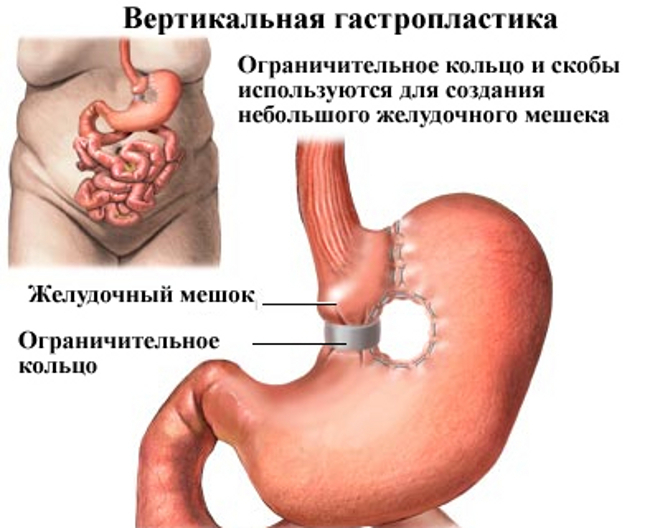 The operation involves the passage of the food lump through all sections of the tract, while maintaining the physiological nature of the digestive act.The technique is quite effective and relatively safe.It is used in patients with an index of 40 to 50. In more severe cases, obesity is ineffective.
The operation involves the passage of the food lump through all sections of the tract, while maintaining the physiological nature of the digestive act.The technique is quite effective and relatively safe.It is used in patients with an index of 40 to 50. In more severe cases, obesity is ineffective.
Gastric bypass surgery
Refers to more radical, but also effective methods of treatment.It has been used since the 60s of the last century.Good results were achieved by this method in patients with overgrowth.Operative intervention decreases the volume of the stomach and changes the anatomical basis of the small intestine.The goal is to limit the absorption of nutritional elements.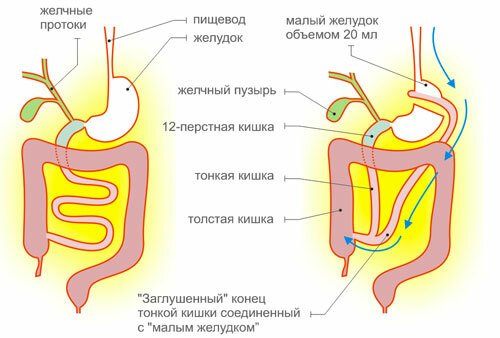 The size of the stomach is limited to a volume of 20-30 ml, followed by cross-linking and transition to the small intestine.The rest of the stomach is not excised, just removed from the act of passing through it a food lump.From the digestive process, the main part of the stomach and the 12-colon intestine "turn off".The volume of food intake decreases.Earlier filling of the small intestine causes a long-lasting feeling of satiety. The operation results in:
The size of the stomach is limited to a volume of 20-30 ml, followed by cross-linking and transition to the small intestine.The rest of the stomach is not excised, just removed from the act of passing through it a food lump.From the digestive process, the main part of the stomach and the 12-colon intestine "turn off".The volume of food intake decreases.Earlier filling of the small intestine causes a long-lasting feeling of satiety. The operation results in:
- progressively reducing weight.Some patients manage to remove up to 75% of excess body weight;
- normalization of blood glucose in patients with type II diabetes mellitus;
- reduced cholesterol and triglycerides;
- to reduce the clinical manifestations of diseases caused by obesity.
Important : effective period of weight loss lasts approximately 18 months.Later patients require additional medication to prevent possible complications.
Biliopancreatic bypass
It was used in the second half of the seventies for the treatment of the most severe forms of excess weight.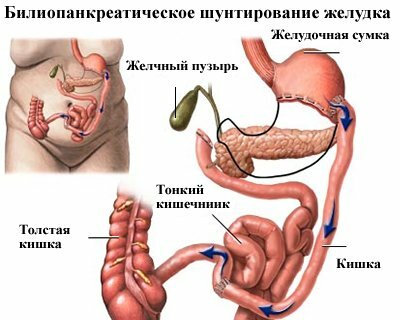 The essence of the intervention is to reduce the stomach and limit the absorption capacity of the small intestine.The volume of the stomach decreases to 100-150 ml.The rest is subjected to removal( resection).After the intervention, the food enters the stomach, reduced in volume, and then into the ileum.It also produces bile and pancreatic ducts, which causes selective absorption of fats and carbohydrates.This change in the structure of the gastrointestinal tract causes a rapidly coming feeling of saturation.The gallbladder and appendix are often removed at the same time.Biliopancreatic shunting( BPSH) with gastric resection is the most complicated of these operations.But its efficiency is the highest.Some patients achieve weight loss almost to normal.Note: BPSH is the only option for surgery, in which patients can eat without restriction.Necessarily in the diet is introduced at least 90 g of protein, minerals, vitamins, iron preparations.
The essence of the intervention is to reduce the stomach and limit the absorption capacity of the small intestine.The volume of the stomach decreases to 100-150 ml.The rest is subjected to removal( resection).After the intervention, the food enters the stomach, reduced in volume, and then into the ileum.It also produces bile and pancreatic ducts, which causes selective absorption of fats and carbohydrates.This change in the structure of the gastrointestinal tract causes a rapidly coming feeling of saturation.The gallbladder and appendix are often removed at the same time.Biliopancreatic shunting( BPSH) with gastric resection is the most complicated of these operations.But its efficiency is the highest.Some patients achieve weight loss almost to normal.Note: BPSH is the only option for surgery, in which patients can eat without restriction.Necessarily in the diet is introduced at least 90 g of protein, minerals, vitamins, iron preparations.
Modified operation of BPSh
Developed 20 years after the normal BPSh.Provides "shutdown" 12-типерстной guts.After longitudinal resection of the stomach, the doorkeeper is kept.The ileum and duodenum are stitched 3-4 cm below it.This leads to the exclusion of participation in the digestion of the contents of the bile and pancreatic ducts, which do not enter the 12-typerstnoy, but into the small intestine.Pay attention : with this method of treatment of obesity evacuation function of the stomach is completely preserved, the possibility of complications development in the form of ulcers decreases. Contraindications to carrying out BPSH:
- malignant tumor processes;
- obesity caused by hypofunction of the thyroid gland;
- severe liver disease;
- is a chronic inflammation of the intestines of severe degrees.
The experienced surgeon recommends the specific choice of the operation necessary for the patient. Theory and practice of treating obesity by surgical methods continues to be a constant search and improvement. Video «Surgical treatment of obesity»:
Stepanenko Vladimir Alexandrovich, surgeon

